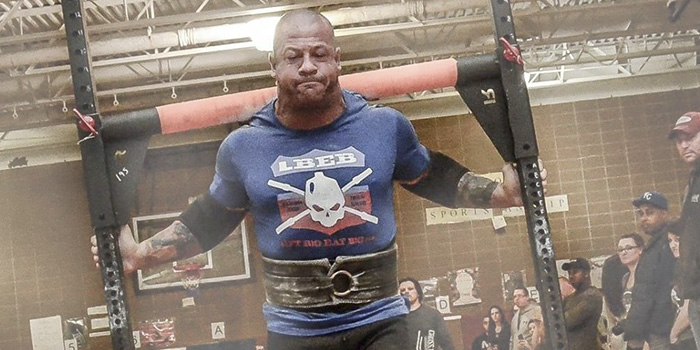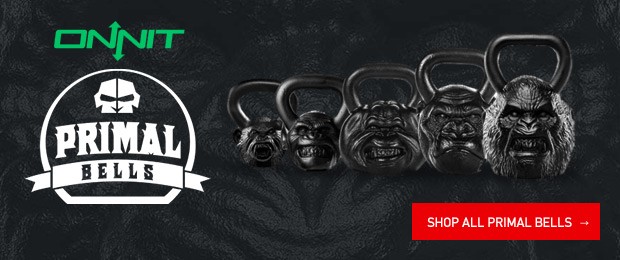
Used correctly, kettlebells can be a vital tool for any lifter. When I originally started my gym, my main clientele was interested in fat loss. I thought that kettlebells were fairly useless, that anything you can do with a kettlebell you can do with a dumbbell. I was lucky enough to have a friend that was RKC certified come show me a few things; needless to say, I was very humbled. I will say that kettlebells are absolutely great for fat loss. Exercises can be explosive, full-body, and easily transitioned to the next movement for complexes.
RECENT: The Bench Press Comeback
Now, by no means am I saying that you should primarily train with kettlebells, but they are a valuable tool. If you are a strength athlete, then you should never abandon the basic barbell lifts, because nothing will get you stronger. For the Strongman athlete, kettlebells are a great accessory after your main lifts. They are also great as “finishers” if you are in need of improving your conditioning, or dropping some extra pounds to make a lower weight class. One thing about kettlebells that makes most people shy away from them, however, is that the technique is very difficult. If you are interested in adding kettlebells to your training program, I suggest you work with someone that has a lot of experience with them.
First, I’m going to outline a few of my favorites for accessory work. These are exercises best done with higher reps after your main lift.
One-Arm Strict Press
You should always incorporate single-limb movements in your training from time to time. Imbalances can develop, especially on an overhead press. When performing a strict press with a kettlebell, there is a greater range of motion than with a dumbbell press. The kettlebell starts in the rack position where it rests on your chest, with your elbow pointing straight down. Your forearm should be tight against your chest, and your fist by your chin as if you were a boxer. As with any kind of strict press, tighten your glutes, core, and quads to avoid using any leg drive. Begin the press by squeezing the handle tightly, then press the kettlebell slightly away from you, bringing it back in to lock out directly over your shoulder joint. Done correctly, there should be a slight arc to your press. Lower the weight the same way by thinking about pulling it down and keeping your lats tight. Make sure to avoid just lowering it straight down, as you would with a dumbbell. The kettlebell should return to the rack position before reversing the movement.
This is a great accessory lift for the circus dumbbell clean and press. Whenever I program for Strongman, I like to have a secondary press day where we begin with a strict press that works on the event. For example, if there is a log press, then the secondary day will be a strict log press. In this case, the balance of the one-arm strict press with a kettlebell will greatly improve the stability and lockout of the circus dumbbell.
I’m also going to add that the bottoms-up kettlebell press is a great way to warm up before heavy pressing. The half-kneeling variation is one of my favorites to start with, as it activates your lower body as well.
One-Arm Kettlebell Floor Press
I love floor presses for an accessory lift for both the bench and overhead pressing. The balance of the kettlebell makes these so much more challenging than a dumbbell. Keep the elbow tucked in on these, and really focus on squeezing the bell through the movement. Make sure that you gently pause on the floor with each rep – do not bounce your elbow off the floor.
Double-Racked Squat
Racked kettlebell squats are extremely humbling for those who have never tried them. The kettlebells will sit in the same place as they would for a strict press. This exercise engages your core and your quads – big time. Kettlebell squats are also a great teaching tool for the squat. With new clients that are untrained, I will start them out with a simple goblet squat. Most people walking into a gym for the first time are not ready to have a bar on their back. For those who are experienced, try goblet squats as a warm-up before barbell lifts to loosen the hips to achieve proper depth. Going back to the double-racked squat, make sure that you squat very low. With the kettlebells racked in front, you will be able to stay upright to break parallel with ease. If you want to make these extra-challenging, add a pause in at the bottom.
Swings
For those of you that have no experience with kettlebells, I’m sure you have heard of or seen a swing. Swings can be great as a warm-up, when going heavy for accessory work, and when doing higher reps for conditioning. When I’m talking about swings, I also mean the Russian swing, not the CrossFit or “American” swing. I don’t care much for the American swing, as I feel the kettlebell snatch is a better exercise if you are going to bring the kettlebell over your head in one motion. However, if you are a CrossFit competitor, by all means keep training the American swing; I will get into snatches later in the article. To perform the swing properly, make sure you are doing a hip-hinge with little bend at the knees. Start the kettlebell out in front of you as I do in the video, and hike it back like a football. Your wrists should come into your inner thigh, and you should think about absorbing the weight in your hips. Explosively reverse the movement by pushing the weight off and standing up tall. Extend the hips all the way and squeeze your glutes tightly at the top. Make sure to not lean back to avoid injury to your lower back – you should be completely upright at the top of the movement.
One-Arm Racked Kettlebell March/Carry
When you want to work your abdominal muscles most effectively, I like to go with anti-movement/rotation exercises. If you compete in the sports of Strongman and powerlifting, then these are the exercises you need: ab wheel rollouts, body saws, and weighted planks. However, working your oblique muscles can be a little trickier. Anti-rotation is critical if you want to move fast with a heavy yoke, or farmer handles. A new favorite of mine is the one-arm racked kettlebell march. You need a fairly heavy kettlebell to do this, as I’m using a 70-pound one in the video. You can do these for time or reps on each side. For reps, keep it in the higher rep range of 20 marches per side. Do your best to keep in perfect posture, not letting the weight slouch you over. Also, another great exercise to do in the same rack position is the one-arm racked carry (for the same reason).
Snatches
I was very excited for my first Strongman competition that had a keg toss, but I had no access to kegs at the time. I was, however, very efficient at the kettlebell snatch with one arm at a time as well as with both arms. I know many of you out there who compete travel (when you can) to Strongman gyms, and may not have access to kegs to throw, or perhaps the weather does not cooperate that day. The kettlebell snatch is the absolute best way to train for this event. At my first keg toss, with a couple of practice throws, I was able to finish the event with the fastest time – I attribute that all to being strong at the snatch. Similar to the swing, it’s all in the hips (Happy Gilmore), so do not squat as the kettlebell comes through your legs. Squatting is a very common mistake here; you want to use your most powerful muscles, which are your hamstrings and glutes. The best cue I was given on these was to think of a fast RDL. Your wrist should make contact with your hips and explosively drive your hips forward, pulling the kettlebell up and punching it to the ceiling. If your goal is to mimic the keg toss, or what’s been in a lot of recent competitions, the sandbag toss, then you want to do the double kettlebell swing, shown here.
Kettlebells are a great tool in any trainer’s toolbox. If you are a coach working with clients mainly interested in fat loss, I highly recommend that you learn how to perform and teach kettlebells. Perfect these moves first, focus on your main lifts (squat, bench, dead, events, etc.), and add these movements in. If you do, you will get stronger and be more explosive as a strength athlete.
Example Strongman/Kettlebell Program
Day 1
Warm-up: Half-kneeling bottoms-up kettlebell press 3 x 10 each
1) Circus dumbbell clean and press 4 sets x 2 reps, 5 set max reps 80%
2) One-arm kettlebell floor press 3 x 10 each
3a) Axle incline bench 3 x 10
3b) Chest- supported row 3 x 12
4a) Incline dumbbell fly 3 x 15
4b) Band pull-apart
Day 2
1) Safety bar box squats 3 x 5 at 80%
2) Yoke 3 x 50ft RPE 8 (rating of perceived exertion)
3) Double-racked kettlebell squats 3 x 12
4) SSB step-ups 3 x 10 each
5) Sandbag carry 2 x max distance
Day 3
1) One-arm kettlebell strict press 3 x 8 each
2a) Circus dumbbell Z press 3 x 8 each
2b) Neutral grip pull-ups 3 x 10
3) Meadows 6 way 3 x 10
4) Face-pulls 3 x 15
5a) Fat grip barbell curls 3 x 10
5b) Tricep press-downs 3 x 15
6a) Dumbbell hammer curls 3 x 10
6b) One-arm kettlebell Tate press 3 x 15 each
Day 4
1) Deadlift 4 x 2, 5th set max reps at 80%
2) Stone series 3 x 5
3) Double kettlebell snatch 3 x 10 or heavy kettlebell swing 3 x 20
4) Glute ham raise 3 x 10
5a) Reverse hyper 3 x 15
5b) Hanging leg raises 3 x 15











3 Comments